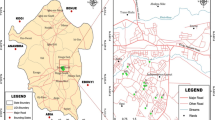Abstract
The supply of water to Khartoum, Sudan, is from wells tapping aquifers in the Nubian Sandstone Formation. The boreholes are located in residential areas where sewage disposal is by means of a siphon septic tank system draining into the water table in the upper alluvial deposits. The aquifers are leaky to unconfined in nature and as the lower groundwater moves from the Nile towards the residential areas, it is susceptible to pollution from the septic tanks. Evidence that such pollution is occurring was found in three production wells where the presence of E. coli bacteria was identified.
Résumé
L'alimentation en eau potable de Khartoum (Soudan) provient de pompages dans la nappe des grès nubiens. Les forages sont situés dans des zones résidentielles où les eaux usées sont évacuées par un système de fosses septiques se déversant dans la nappe phréatique superficielle des alluvions. La nappe des grès nubiens est naturellement libre ou captive avec drainance et s'écoule du Nil vers la zone résidentielle. Elle est susceptible d'être polluée par les eaux usées infiltrées. La preuve d'une telle pollution résulte de l'identification de la bactérie E. coli dans trois puits de pompage.
Similar content being viewed by others
Author information
Authors and Affiliations
Additional information
Received: 9 July 1998 · Accepted: 20 May 1999
Rights and permissions
About this article
Cite this article
Abd Alghaffar Abd Alraheem, M. Pollution in the water supply wells of Khartoum, Sudan. Bull Eng Geol Env 58, 257–264 (2000). https://doi.org/10.1007/s100649900021
Issue Date:
DOI: https://doi.org/10.1007/s100649900021




